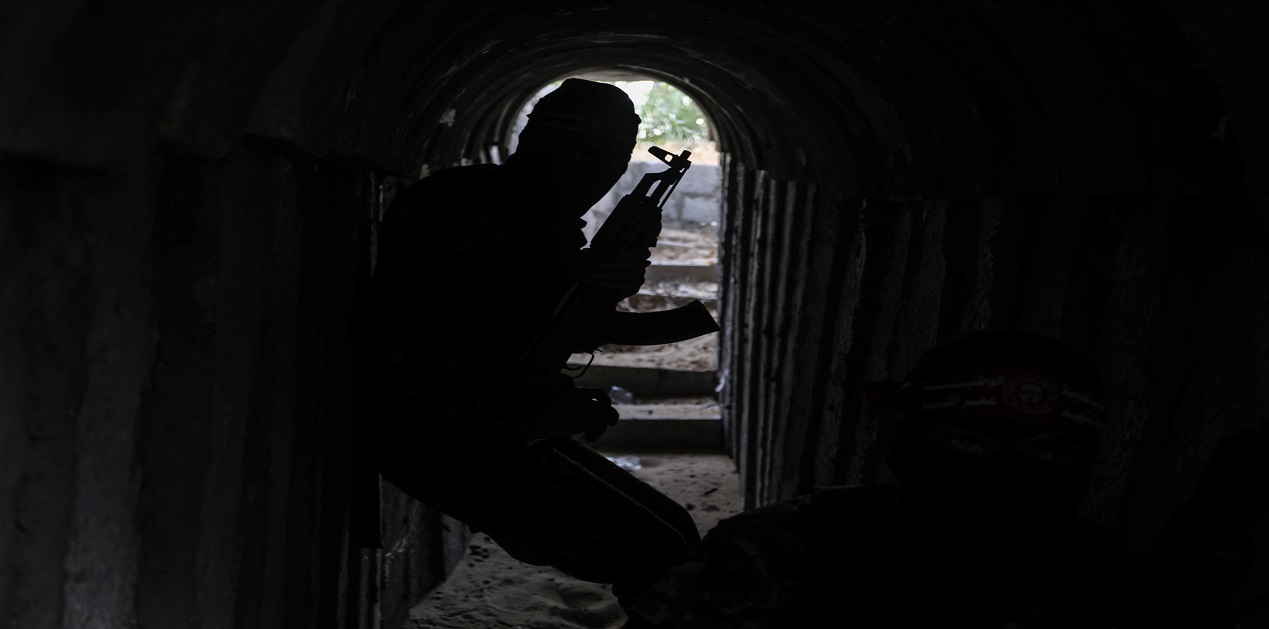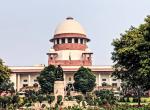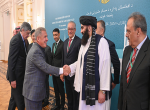Hamas executed a well-planned multifaceted military operation, breaching the Gaza fence after neutralizing Israel’s sensors, automatic machine gun towers and communications nodes to execute civilians; take hostages and desecrate bodies of the dead. The attack ostensibly challenged Israel’s military deterrence and demolished its invincibility. Ghazi Hamid, a Hamas spokesman said, “We showed that Israel is…not a strong country, it can be defeated and stopped with small groups of brigades, not an army.” More likely Hamas’s attack also posed a direct challenge to President Mahmoud Abbas of Palestine who had attempted to normalise situation in Gaza.
Israel expectedly retaliated and continues to do so almost a month after the Hamas attack. It has destroyed large amount of infrastructure and imposed many restrictions in Gaza. Many world bodies have appealed to Israel for toning down its offensive but Israel stoutly refuses. Lately, Yemen is said to be joining the war against Israel. Iran has also warned of taking strong measures against Israel.
Much has been written about the present conflict and its possible global implications. In contrast, this discussion focusses on certain aspects that have received less attention.
The Scenario
Despite the widely acknowledged military capabilities of Israeli the pace of its Gaza offensive is slow. The operations are restricted by mainly three factors - urban battle setting, subterranean challenge and some 200 plus Israelis held hostage by Hamas in the tunnels. All of these are to Israel’s disadvantage.
War Waging Capabilities
Hamas strategy is to intermingle with local population in urban areas and close to city infrastructure, and thus stay protected. It avoids conventional military operations but seeks ‘opportunity engagements’. This necessitates the Israel Defence Force (IDF) to conduct Urban Warfare (UW) operations in Gaza. In stark contrast, the IDF main strength lies in conducting mobile operations on open, barren plains. The size of Gaza strip restricts this capability and any offensive IDF action will necessarily result in infrastructural damage and destruction or ‘flattening’ associated with UW operations. Thus, UW changes the combat dynamics for IDF in Gaza.
Subterranean Tunnel Network
In 2006, Hamas started creating a tunnel network under Gaza’s border with Egypt in order to smuggle in food and fuel and thwart a combined Israeli Egyptian blockade. Since then, this network was incrementally developed to its present shape.
During 2014 war against Hamas the IDF discovered the Hamas tunnel network had expanded into a vast, labyrinthine network beneath the coastal Palestinian areas connecting Gaza City with other towns and refugee camps. Majority of the tunnels were equipped with electric lights, air ventilation and water pipes, with some walls and archways reinforced with metal and concrete. Some tunnels were 160 feet below ground level with others at 230 feet. The tunnels housed command and control centers, missile storerooms, launchers and other weapons; dormitories (rest areas) for fighters, stored with food. Some tunnels had been outfitted with rails for transport of cement.
Presently, it is estimated that a total of 500 km network exists comprising 1300 tunnels - each two meters high and two meters wide - buried at a depth of 70 meters (229 feet). It is estimated that top Hamas leaders and commanders with 30000 ‘soldiers’ can live there. The tunnel network allows ‘at will’ deployment and movement of missiles and fighters to strike Israel or its forces operating nearby.
A bank of gasoline operated engines power the ventilation of tunnels. The din raised for Israel to allow fuel into Gaza – ostensibly to assuage the critical power situation - is, partially, to get fuel for operating the tunnel ventilation. In its absence, Hamas fighters would have to surface thereby providing IDF elimination opportunities.
Tunnel Warfare
The depth, scale, configuration and possible holding of 200 plus Israeli citizens inside Hamas tunnels, requires intricate planning at operational level and elite troops with special training, equipment. This alters the nature of fighting and becomes a major factor checkmating Israel’s intrinsic capabilities.
The possibilities of IDF encountering explosives, Hamas fighters with Israeli hostages imposes adequate caution on IDF, requiring detailed planning and execution for its envisaged operations. Obviously, IDF would avoid brute force entry and clearance operations. Resultantly, the tunnel clearance phase will be lengthy and long drawn. The following summarises the laborious and specialised process for tunnel clearance.
Once encountered, the tunnel layout needs to be determined before assaulting it. Specialist units map tunnel layout using special ground penetrating radar, drilling equipment and hyper-spectral sensors. Their inventory also has a mix of ground robots (with remote controlled machine guns or grenades to fend off Hamas defenders), flying robots (controlled by drone pilots to map the tunnel interior and determine who or what maybe inside). The tunnel assault groups require special radios, navigational gear and thermal night vision goggles capable of working underground; to enter, navigate, clear and finally destroy the underground labyrinth and minimise risk to IDF soldiers. Dog squads, specially trained for underground operations, assist IDF commandos.
In addition, special Israeli units including the Army’s Sayeret Matkal (counter-terrorism and hostage rescue beyond Israel's borders) and Yamam (one of four Border Police special units capable of both hostage rescue operations and offensive take over raids against terrorist targets in civilian areas) form part of the overall force deployed for such scenarios.
IDF commandos can call in air strikes with “bunker buster” munitions such as the GBU-28, capable of penetrating 100 feet of soil or 20 feet of concrete. Israel also uses a combination of explosives, bulldozers, tanks and Sponge Bombs to destroy or seal off tunnel entrances.
The “Sponge Bombs” contain two non-explosive chemicals that, when combined, create a dense foam that rapidly expands and hardens. As Israeli troops move through the tunnels, these devices could be used to seal off side passageways to prevent Hamas ambushes. (Adequate care is taken to prevent these from injuring IDF troops).
Israel has relentlessly bombed Gaza for almost a month killing thousands of Palestinians so far. Wide swaths of landscape has been pulverised, heavily populated enclaves reduced to rubble and an estimated 700,000 people turned into internally displaced refugees. The exact damage to Hamas tunnels so far is unclear.
Siege
Ancient military history records many aggressors who have encircled a defender to wear him down. Long Sieges have become less favoured in today’s high manoeuvrability wars. This is now the case in Gaza.
Sieges are complex and critical components of UW there being no other way of forcing the entrenched adversary out in the open or isolating him from the unarmed civilian population. Siege dynamics also magnify the problems of fighting in confined spaces. Invariably, non-combatants in the area face discomfort.
Presently, both belligerents’ actions have effectively given rise to a de-facto siege on the Gaza population. Hamas merges with and hides behind the population. Such ‘internal siege’ prevents Palestinians from migrating southwards as required by Israel. Concurrently it also denies flow of information about Hamas’ capabilities, resource capacity, logistics sustenance and disposition. In sum it denies all information to Israel.
Israel likewise suspended phone and internet communications into/ from Gaza (as the communication infrastructure is provided by Israel). It has also enforced movement control, regulated supplies, denial of water, food, medicines, fuel with an aim to expediting Hamas towards exhaustion.
Israel holds that imposing sieges is wholly acceptable so long as civilian populations are allowed to leave the city. By requiring Gaza civilians to migrate south, Israel sought to apply a “micro siege” on Hamas by filtering out civilians.
Theoretically, based on time duration, sieges can be categorised into tactical battles (30 days or less), operations (of one to six months duration), and strategic (six months to one year). Any future sieges by Israel will likely be “microsieges”, radiating from Israeli bases of power, focussed on tactical and operationally relevant military and potentially political objectives to alienate local population from Hamas and its eventual defeat.
Perception Wars
Civilians and Militants
Characteristically, any engagement with a non-state actor blurs the distinction between civilian and armed populations. Their co-location provides the armed group with inherent anonymity and security and is amply demonstrated in present case where adequate concealment is accorded to Hamas cadre, its strength and weapons. Hamas has made logistics and command centres beneath hospitals, schools and other public places. In addition it recruits locals – especially those living along the border – into its cadre to fight IDF. These compound the difficulties of identification and neutralization by Israel.
Hamas may be getting pounded militarily but they are seemingly winning the perception war. Social media and Google is awash with textual and graphic content that projects only the sufferings of the Palestinian old, women and children; starvations; deprivations like availability of only dirty drinking water; hospitals that are damaged and overflowing and relentless bombing by IDF. Pictures abound regarding all round devastation and injured children, lying amidst the rubble of their erstwhile homes. The fact that Hamas unleashed the present wave of crimes upon the Israelis is no longer being talked about.
Israel allowed 20 truckloads of medical supply and water to enter Gaza from ¬¬¬¬-Rafa 20 days after their offensive began. This was branded ‘inadequate’. Israel also reopened two of the three pipelines bringing water into Gaza. Col Elad Goren, head of Coordination of Government Activities in Territories (COGOT) stated that Israel is daily assessing humanitarian situation in Gaza and working with Humanitarian Agencies. With these concessions, Israel attempts to fence off severe censure.
Social Media
Both belligerents aired footage of attacks against their respective citizens on social media. Initially, Israelis (who pride themselves on their military dominance) were seen hunkering down in their bomb-shelters. The carnage unleashed by jeep and motorcycle borne Hamas fighters against unarmed civilians on the streets of small Israeli towns and kibbutzs like Re’in was highlighted. Though gory, the effect of these was short lived. In contrast, Hamas videos make longer impact. Initially these showed breaching of the fence and rockets degrading the much touted Israel Iron Dome, later ones showed wailing and shocked Gaza population amongst rubble of their erstwhile dwellings.
Paradoxes
Propaganda
Israel defends its actions on grounds of being the target of unprovoked killings, murders and hostage taking by 07 October attacks. The newer generation of Israel would neither forget nor forgive Hamas for the 07 October attack and carry this into adulthood. Israel at best can refer to Hamas using Gaza population as human shield and seeking safe sanctuaries under / inside hospitals, public and educational buildings. It also emphasises having provided an opportunity to Gaza residents to move southwards to safer areas, thereby partially absolving itself from the widespread damage and destruction inflicted and associated with UW operations. Ironically these have proven short lived and gained no / less traction internationally.
On the other hand, numerous visuals showing ‘flattened’ city infrastructure provides adequate propaganda material to Hamas. Israel is depicted as a brutal monster inflicting untold devastation and deprivations on the Gaza population. Hamas even exploits the events when its fighters occasionally emerge from tunnels to target Israeli forces to demonstrate inability of IDF to counter Hamas.
Effectively, Hamas started the present war and now plays the victim card, complaining about the horrors of war. Paradoxically, Hamas finds support on the world stage and many organisations have called Israel to suspend its punitive actions. Ironically, when siege is resorted to by Israel, these are construed as human rights violations at local and international levels. Paradoxically, the equation has swung in favour of Hamas following the IDF retaliation.
Techint and Humint
Presently, many hold the view that precision sensors and weapons available today generate adequate pre warnings making it progressively harder for armies to go on the offensive. As known, Hamas resorted to primitive methods and its attack defeated the world’s most advanced surveillance technology. It proves that if an attacker is diligent and a defender complacent technology can be defeated. This underscores that Humint cannot be entirely relegated.
Social Media
Mr Netanyahu tweeted and blamed the intelligence community for its failure, but immediately withdrew his tweet as Israeli establishment objected to the allegation. While Israel stands united today, Mr Netanyahu’s leadership will be seriously questioned soon after the present turbulence subsides.
Hamas has skilfully exploited a fatal weakness in the character of the Palestinian and global population, their inherent gullibility and vulnerability to yield to compassion. Their narrative builders have meticulously downplayed the fact that Muslim countries (including Egypt and Jordan) have not shown any inclination to take their co-religionist refugees from Gaza in the name of Islamic solidarity.
Conclusion
Hamas has apparently gone underground and utilizes its tunnel network interlinking disparate parts of Gaza. Sieges will play an important part in countering the challenge. Given the siege-friendly nature of Gaza, it is safe to assume that micro sieges would become a regular occurrence in Israel’s effort to identify resistance centres and neutralize them. Consequently, Israeli offensive will be long drawn.
Multiple considerations may elicit concessions from Israel regarding relief flow into Gaza. However Israel would control its frequency, volume and type of relief into Gaza.
Expectedly, civil population in Gaza would resist frequent relocations. This will result in damage to their assets, resources and protection even from precision munitions. International community should prepare itself for this Catch 22 scenario.
International pressure may force Israel to declare a unilateral ceasefire. However periodic eruptions of violence in Gaza are not likely to be eradicated. Chances are that the world may again witness an even more horrendous replay of the October 7 slaughter, rape and hostage taking.
The Hamas narrative has galvanised world opinion – partly - in its favour. However, the Gaza problem requires finding a long term solution.
(The paper is the author’s individual scholastic articulation. The author certifies that the article/paper is original in content, unpublished and it has not been submitted for publication/web upload elsewhere, and that the facts and figures quoted are duly referenced, as needed, and are believed to be correct). (The paper does not necessarily represent the organisational stance... More >>
Image Source: https://assets.bwbx.io/images/users/iqjWHBFdfxIU/ikC37csg1QX4/v2/-1x-1.jpg











Post new comment